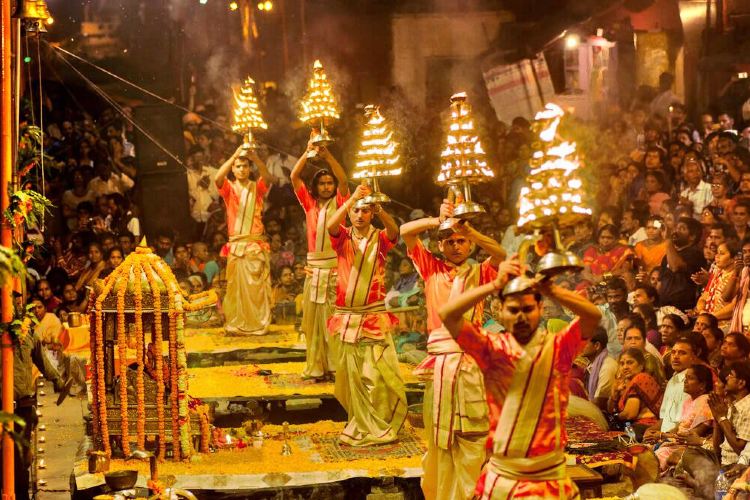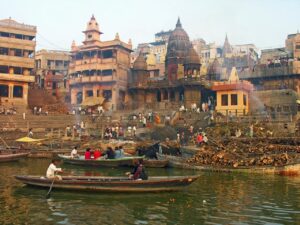
4 Famous Ghats Of Varanasi The Holy City
Benaras – A City Older Than History, Tradition, & Legend.
Varanasi – The eternal City of India.Banaras or Kashi or The City of Mother Ganges are the other name of this devout place. Call it by any name, Varanasi is one of the medieval consecutively colonized communities of the globe. Banaras city is all the more so momentous since its extraordinary peers Beijing, Jerusalem, and Athens have proceeded onward and away from the old lifestyles. Benaras is also famous for its ghats, some most famous ghats of Varanasi we are going to know about in this blog.
Apart from this, the paths, roads, and structure of aged Benaras actually overflow the ethos of antiquated India. Over 3000 years of age, this city has been alluded to by different voyagers as “across multiple time zones”. This holy city Varanasi is momentous from numerous angles. Kashi is one of the seven sacred cities of Sanatan Dharma and the major pilgrims center for Hindus, Buddhist, and Jains.
How Many Ghats in Varanasi?
Ghats in Benaras are riverfront steps prompting the bank of the Ganges. Varanasi has total number of 88 ghats. Most of these ghats are used by people to take bath and performing numerous spiritual rituals. Few of them are used only for incineration.
Maximum number of ghats in Benaras were constructed after 1700 AD, when Marathas were ruling on the Kashi. Many ghats like Dashashwamedha, Manikarnika, and Raja Harishchandra are related with legends or folklores and their destinations have existed since days of yore. Some others main ghats Varanasi like Ahilyabai Ghat, Ganga Mahal Ghat, & Chet Singh Ghat were later augmentations.
Most Famous Ghats Of Varanasi / Popular Ghats Of Benaras
If you want to feel the magic of Varanasi, have a walk along the popular Ghats of Varanasi to enjoy an enchanting experience. At Traveling Freaks, we are showcasing some of the most famous Ghats of Benaras.
Dashashwamedha Ghat
Assi Ghat
Manikarnika Ghat
Harish Chandra Ghat
Dashashwamedha Ghat – A popular ghat of Varanasi for religious ceremonies
Dashashwamedh is one of the most famous Ghats of Varanasi and has number of Hindu temples and shrines; where pioneers come from everywhere to operate religious ceremonies and ceremonies. A number of devotees comes to this ghat every morning to honor Lord Shiva and take bath in the holy water of Ganga; while during the evening Ganga Arti, which see a great many gliding lights inundated in the river, draws in colossal groups from all over.

Dashashwamedh signifies ‘the ghat of 10 sacrificed horses’. As per the Hindu mythology, ten ponies were atonement by Lord Brahma to permit Lord Shiva to get back from a time of expulsion. Whether you consider the age of Dashashwamedh Ghat or not; this ghat is appealing, bright, and comparatively clean, and even detractor are fascinated in by its environment, routine rituals, and alluring riverfront glimpse.
Assi Ghat – A popular ghat of Benaras to offer water on the lingam of Lord Shiva
Assi Ghat is one of the biggest and famous ghats of Varanasi that is almost the uttermost south to the other major ghats, Assi attracts fans’ droves. This spot is especially significant for what it’s worth here that River Ganga meets the Assi river. Devotees and visitors visit this attractive ghat to worship a lingam of Lord Shiva, kept underneath a peepal tree.

The dusk arti of Assi Ghat makes it more astounding place when mantras are recited, conches are blown and surprisingly the air feels weighty with a profound intensity. This ghat is the starting point for boat rides and one can reach here to enjoy early morning yoga sessions, religious music, and Subah-E-Benaras.
The old ones’ dictate that the Goddess Durga, afterwards assassinating demons Shumbha-Nishumbha, tossed her dagger in a stream of ganga at Assi Ghat. That is the reason this ghat has been titled so. While the evening arti welcomes guests consistently, the ghat is particularly packed during the long stretches of chaitya (March/April) and magh (January/February). Other critical occasions like lunar/sun oriented obscuration, Makar Sakranti and Probodhoni Ekadashi additionally see amassing swarms.
Manikarnika Ghat – A most popular ghat in Varanasi for incineration
Quite possibly the most propitious and hallowed ghats of the Hindus, Manikarnika Ghat is a momentous ground for incineration. It is situated between Dashashwamedh Ghat and Scindia Ghat. There is a puddle nearby the Manikarnika Ghat that is presumed to have been burrowed by Lord Vishnu so that Lord Shiva and Goddess Shakti could take the dip. A foot imprint near the lake is known to belong to Lord Vishnu, left from when he had pondered in Varanasi. When one goes up to the stairs, one can see a notable tank which is also known as Manikarnika Kund. It is said that Goddess Parvati dropped her diamond (Mani) earring (Karn) here and Lord Shiva shovel a hole to discover it. It is said that the downturn was loaded up with his perspiration, in this manner bringing about a well.

Manikarnika Ghat has also indicated in literature of 5th century. Additionally, it is said that when Goddess Shakti sacrificed herself during her father’s fire rituals, her better half Lord Shiva was deprived, and maddened with misery, he drifted the body of Goddess Shakti on his shoulder and traversed the entire universe. Frightened Lord Vishnu with the Lord Shiva Tandava destroyed Shakti’s body with his chakra where her stud fell to save the universe.
Harish Chandra Ghat – A most popular ghat in Varanasi for incineration
Harish Chandra Ghat is one of the two incineration ghats and is otherwise called Adi Manikarnika, which implies the first creation ground. It is a lot more confined than Manikarnika that is a more important ghat for incineration. Notwithstanding, Hindus come from obscure places to this cremation ghat to have their dead incinerated here as many accept that they would get moksha (salvation).

This is perhaps the most established ghat in the heavenly city of Varanasi and has been named after mythological ruler Harish Chandra. It is said that the king once dealt with this ghat for the diligence of truth and noble cause.
The lord fascinated with his undertakings remunerated him and reinstate his lost realm and dead child to him. The ghat was modernized in 1980s when an electric crematorium was set up here.

Leave a Reply